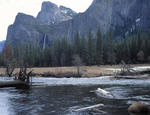The lightning caused fires of July and August continue to burn in Yosemite wilderness and are being managed for multiple objectives. This means fire managers and firefighters may use less aggressive or minimal actions where the fire is accomplishing benefits on the land. For example, the fire may burn the understory of trees, ridding the area of accumulations of dead and down vegetation.
In wilderness areas, Minimum Impact Management Tactics (MIMT) are utilized by using natural barriers of rock and lakes, or utilizing trails and past fires thereby lessening the use of aggressive hand tools, i.e. chain saws. Utilizing the minimal tool and natural features further reduces the work needed to rehabilitate the fire area. Firefighters do this without diverting their attention from the safety of themselves or the public. These adjustments firefighters make to effect minimum resource impacts are essential if the spirit of wilderness and National Parks is to be maintained.
Slope fire: (37 54.572 x 119 40.924); 6900’ el., Tuolumne Co). The Slope fire has grown to approximately 619 acres, with the most movement to the east. Light smoke may continue to be visible along Tioga Rd, White Wolf area, O’Shaughnessy Dam of the Hetch Hetchy Reservoir, Rancheria trail area, and in the Tuolumne Meadows area. The fire remains a creeping surface fire through duff and other down vegetation. The mixed conifer forest is on a north aspect, with cedar and white fir trees, down tree limbs and compacted short needles as the predominate vegetation. Fire resources have been reduced to 7 fire monitors.
All trails in the Harden Lake area are now open. The immediate Harden lake area is open to hikers for day use only. Hikers are reminded to stay on trails through the fire area.
Vernon: (37 59.813 x 119 43.618); approximately 7000’ el., Tuolumne Co. This fire is at 47 acres, and is the result of a single tree being struck by lightning August 8, 2010. The most active part of the fire is to the southwest and southeast, with 75% of the perimeter active. It is backing downhill, with 2 foot flame lengths. This fire is in designated wilderness, and will be managed for multiple objectives primarily forest restoration. It is approximately three miles north of Hetch Hetchy Reservoir and one half mile south of Lake Vernon. There is significant lightning caused fire history near this fire; the most recent being the 2006 Frog and the 2005 Wapama fires. The fire is in a predominately red fir and Jeffery pine forest. Fuels burning are needle litter and other down and dead vegetation. Five fire monitors are assigned.
Cooperators for both the Vernon and Slope fires include the San Francisco Water Quality and Public Utilities Commission at Hetch Hetchy, and the Tuolumne County Air Pollution Control District.
A south to southeast air flow will aid in smoke dispersion through the rest of the week. Early morning smoke may be present down the Grand Canyon of the Tuolumne.
Clark Fire: (37 40.925 x 119 29.873): approximately 7,000’ el., Mariposa Co. This 11 acre fire is out and in is in patrol status.
Other fires: The Tuolumne and the Wildcat fires are both inactive.
New Fire: Pohono: This fire was reported by a tourist seeing smoke near the Pohono Bridge in Yosemite Valley, August 17. The 50’x20’ fire burning in oak litter and was determined to human caused and was put out. This fire is a reminder to all to be diligent with camp fires and smoking and being sure all fires are out.
Yosemite Fires – Update #13 – August 18, 2010
All posts are those of the individual authors and the owner
of this site does not endorse them. Content should be considered opinion
and not fact until verified independently.
Sorry, only registered users may post in this forum.


